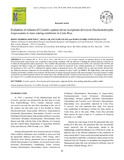Mostrar el registro sencillo del ítem
Evaluation of volumes of Ceratitis capitata larvae in exposure devices to Diachasmimorpha longicaudata in mass rearing conditions in Costa Rica
| dc.creator | Morera Montoya, Rossy Marcela | |
| dc.creator | Blanco Metzler, Helga | |
| dc.creator | González Lutz, María Isabel | |
| dc.date.accessioned | 2020-01-07T14:48:58Z | |
| dc.date.available | 2020-01-07T14:48:58Z | |
| dc.date.issued | 2019 | |
| dc.identifier.citation | http://52.172.152.24/index.php/jbc/article/view/185066 | |
| dc.identifier.issn | 2230-7281 | |
| dc.identifier.issn | 0971-930X | |
| dc.identifier.uri | https://hdl.handle.net/10669/80193 | |
| dc.description.abstract | Five volumes (60 cc, 70 cc, 80 cc, 90 cc and 100 cc) of L3 of Ceratitis capitata in exposure devices to the parasitoid Diachasmimorpha longicaudata were evaluated in mass rearing conditions with the objective of finding the optimal quantity of host larvae to obtain the best parasite quality parameters. The variables like parasitism, sexual proportion and fertility were analyzed with ANOVA and compared with Tukey’s range test. Significant differences were found for treatment in the variable parasitism (ρ = 0.0244), showing that the treatments of 60 cc and 70 cc obtained the highest number of parasitized larvae. The variables like sex ratio and fertility did not show any difference between treatments, but for fecundity there were variations for days 5 and 3 (ρ<0.0001). The flight ability, male and female mortality and fertility variables were analyzed with the model of logistic regression analysis with autocorrelation correction (response variable is binomial), for which treatment effects were found only in the variable mortality of males for the treatment 70 cc. According to these results, the volume of 70 cc would be the promissory treatment for industrial production in order to obtain greater parasitism and a longer life of males | es_ES |
| dc.description.sponsorship | Universidad de Costa Rica/[]/UCR/Costa Rica | es_ES |
| dc.language.iso | en_US | es_ES |
| dc.source | Journal of Biological Control, vol. 33(2), pp.80-87 | es_ES |
| dc.subject | Ceratitis capitata | es_ES |
| dc.subject | Diaschamimorpha longicaudata | es_ES |
| dc.subject | Exposure device | es_ES |
| dc.subject | Mass rearing | es_ES |
| dc.subject | Parasitism | es_ES |
| dc.subject | Quality control | es_ES |
| dc.title | Evaluation of volumes of Ceratitis capitata larvae in exposure devices to Diachasmimorpha longicaudata in mass rearing conditions in Costa Rica | es_ES |
| dc.type | artículo original | |
| dc.identifier.doi | 10.18311/jbc%2F2019%2F22715 | |
| dc.description.procedence | UCR::Vicerrectoría de Investigación::Unidades de Investigación::Ciencias Agroalimentarias::Centro de Investigación en Protección de Cultivos (CIPROC) | es_ES |
| dc.description.procedence | UCR::Vicerrectoría de Docencia::Ciencias Sociales::Facultad de Ciencias Económicas::Escuela de Estadística | es_ES |
Ficheros en el ítem
Este ítem aparece en la(s) siguiente(s) colección(ones)
-
Agronomía [1485]


